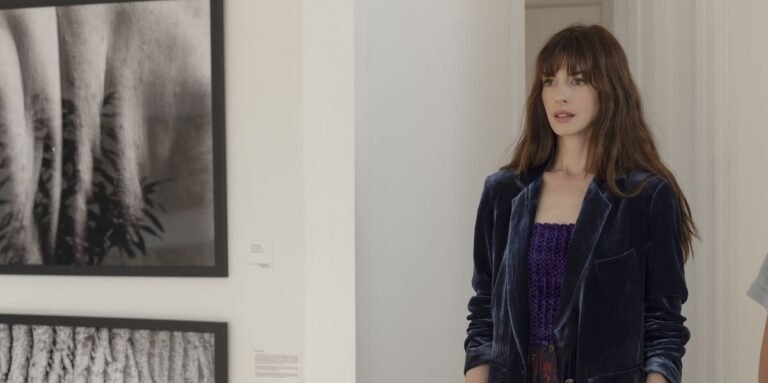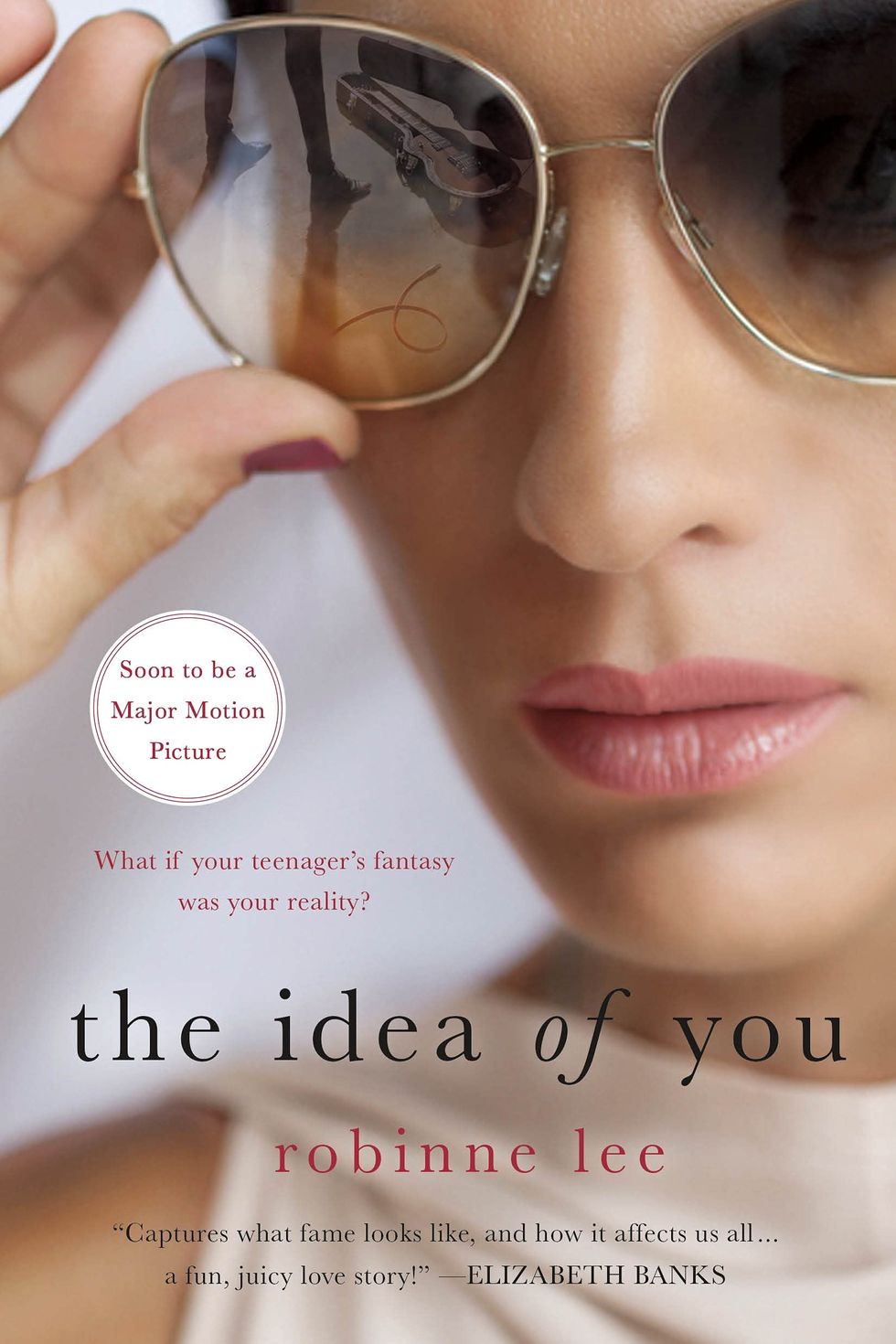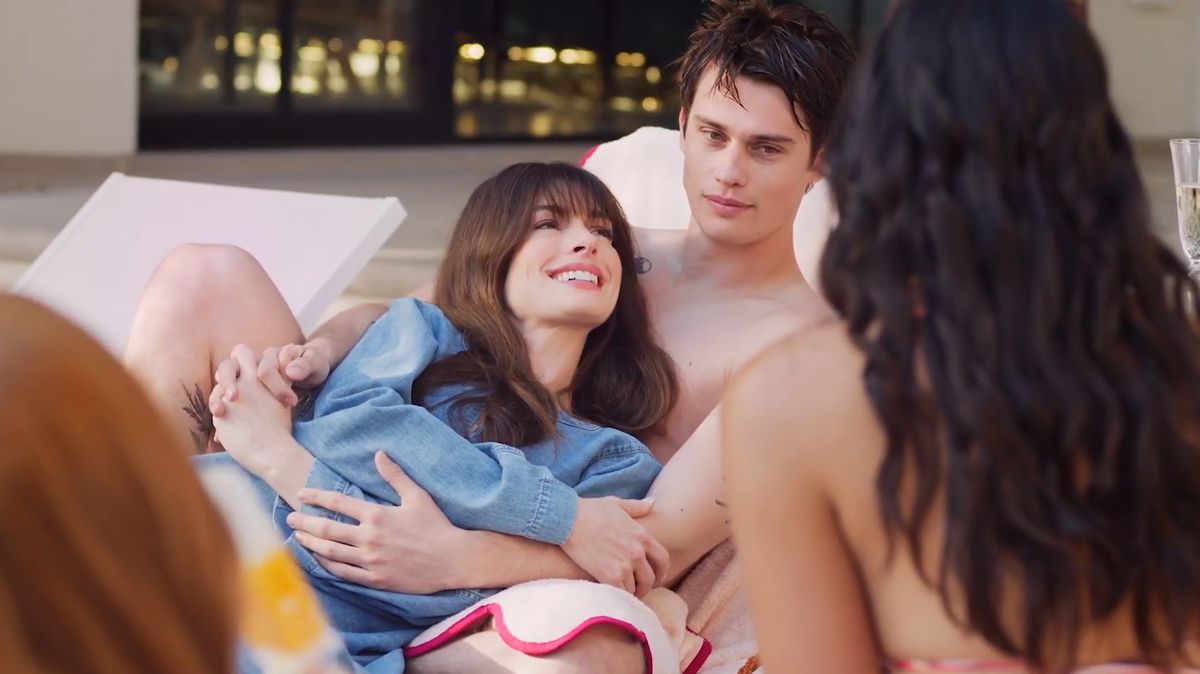In The Idea of You, Anne Hathaway stars as Solène, a 40-year-old divorcée who runs her own art gallery. While her romance with boy band singer Hayes (Nicholas Galitzine) is the main draw of the film, the art in Solène’s gallery is critical to the plot—and tells its own subtle, yet important story.
“We worked really hard to make the art a focal point and make it authentic,” production designer Amy Williams tells Town & Country. “One thing I’m really proud of as a production designer is that I use real artists in almost all of my films. That’s hard to do these days with legal clearance, but it’s so important for shaping the character, what they have on their walls. When you see a boring abstract, it’s too safe of a choice. And I don’t like making safe choices. I like making daring choices!”
When Williams read the script for The Idea of You, written by Michael Showalter and Jennifer Westfeldt (adapted from Robinne Lee’s novel of the same name), she felt pulled to work on it, drawn to the character of Solène. Much like Solène, Williams began her career in the art world. After graduating from Michigan State University with a degree in art history, she moved to New York City, beginning her career in galleries. “It suddenly just wasn’t the right environment for me,” she recalls. So she went on Craigslist, found a project that needed an art director, and made the transition to film and television; since, she’s worked on productions such as Master of None and WeCrashed, and won an Emmy for her production design on A Crime to Remember.
Hathaway, who also served as a producer on the film, partnered with Williams on choosing the art, and was “very involved” in the process. The pair began their search for artists in the Silver Lake neighborhood, the location of Solène’s gallery. There was a distinctly East Coast-flavor to the gallery as well; as Williams and Hathaway both live in New York, they would discuss their favorite galleries in the city, and, since The Idea of You filmed in Atlanta, they also included local artists. In the movie, Solène’s collection emphasizes diversity and lesser-known artists, and so they found inspiration in galleries that echoed that philosophy. “I always love giving artists exposure, and giving them the money that we can offer to use their art because artists are often so exploited,” she says. “It was really fun going on studio visits and meeting artists in Atlanta.”
They spent so much time sourcing artwork because in addition to the collections in Solène’s home and office, Williams and her team curated three separate art shows for Solène’s gallery, each with its own distinct aesthetic. The art moved the story forward; the first show, the backdrop for when Hayes seeks Solène out after their Coachella meeting, has a muted palette, featuring “organic, textural, simplified” art, whereas the second show is brighter, mirroring the glamorous world of boy bands and world travel. The third and final show is what Williams describes as the “most Solène,” with artwork that features includes punctuated colors rooted in “a sense of home and place.” That final show includes artwork by Lori Glaven, Suzy Lindow, Macarena Luzi, Sebastian Curi, Teddy Kelly, John Divola, and Susan Hable.
While the bulk of sourcing artwork for the film was for those three gallery shows, one specific piece of art in the film, “Unclose Me,” plays a significant role in Solène and Hayes’s relationship. In Lee’s novel and in the script, the painting is described as a reclining nude, and after hearing Solène describe her love for the work, Hayes secretly purchases it for her. In the film, when Hayes first shows up to Solène’s gallery, she brings him to see work that is not on display—including “Unclose Me,” which is not a nude in this telling, but rather a work by Sarah Anne Johnson. (Hayes later buys the piece for Solène, but she doesn’t find out about the gift until she returns home after breaking up with him.)
When searching for “Unclose Me,” Williams says, “we had a collection of over a hundred artists that we really liked and all of their available work that we could clear. We pinned it up on a board, constantly rearranging how it should go and what it would be like. We had pulled more literal nudes. There’s the painting of the beginning of the film that she gives her friend Tracy [played by Annie Mumolo], and at one point that was going to be the ‘Unclose Me’ piece, but it just seemed like it was too literal for the story and how things were evolving.”
She continues, “When you’re making a film and you’re working with these really great collaborators, themes start to develop from the story and from the script. The color indigo became a really deep color for our character Solène, and that painting didn’t have indigo. We’re like, ‘we really need to find indigo for this. It really means a lot.'”
When she came across this piece by Johnson, Williams was on a plane back to New York City with Hathaway and costume designer Jacqueline Demeterio. “It was my first time on a private jet, and we’re sitting there, talking about art, and our favorite galleries,” Williams says. “Annie actually found Sarah Ann Johnson, and we started looking through the different pieces and talking about who do we know that knows this gallerist? I had a friend of a friend, Anne’s husband had a connection, so we reached out. We all felt like it was magical—it wasn’t literal, and it gave all the feelings.”
Peppered through The Idea of You are plenty of Easter eggs hidden in the art. For example, a collage piece hanging in Solène’s home was made by the production’s first assistant director, John “Tag” Tagamolila, and there’s a hidden significance to the work in Solène’s gallery by artist Reed Knauth, who owns the space that the production transformed into the fictional gallery. “We changed her gallery—we ripped out the doors and changed the walls—but we wanted to have that little Easter egg of: This is the owner of the gallery and this is her piece,” Williams says.
Other artwork featured had deeper meaning for the creatives behind The Idea of You. In the film, Solène and Hayes discuss “Self-Portrait” by Linda White, a calendar that appears on the wall of her studio’s warehouse. That piece was actually from director Michael Showalter’s childhood home; he grew up with that painting, and he felt passionate about including in the film. Similarly, Hathaway wanted to include work by Spencer Lewis, an artist featured in her own home. “There’s a very quick scene where the paparazzi takes a photo of [Solène] at an L.A. art gallery, and Anne was like, ‘I think it should be this guy who I own.'” The scene, and Lewis’s artwork, is a blink-and-you-miss-it moment, but it meant a lot to Hathaway to include him.
As viewers watch The Idea of You, Williams hopes they notice the thought and care that went into selecting the various paintings, ceramics, and prints included.“A lot of people have to get involved when you’re putting artwork in a film,” she says. “It’s not just a matter of throwing something up on the wall.”
The Idea of You is now streaming on Prime Video. Watch now
Emily Burack (she/her) is the Senior News Editor for Town & Country, where she covers entertainment, culture, the royals, and a range of other subjects. Before joining T&C, she was the deputy managing editor at Hey Alma, a Jewish culture site. Follow her @emburack on Twitter and Instagram.








